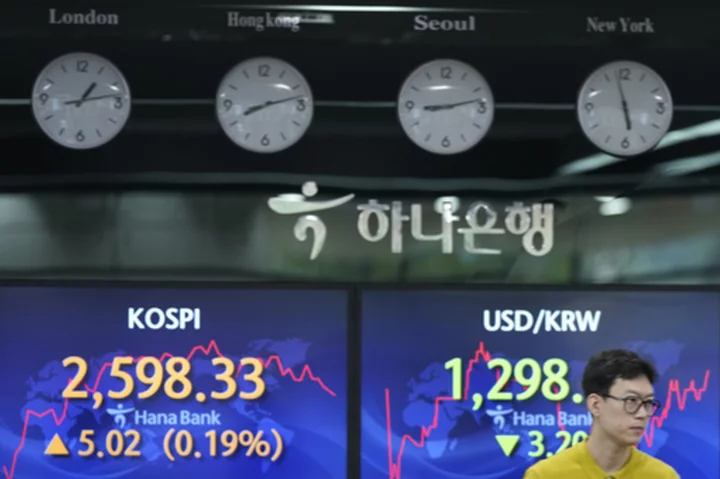Manufacturers around the world are contending with weakening demand as the economic outlook for the industry darkens.
Factories in the United States and across the eurozone reported a decline in new orders for manufactured goods in May as they worked through their backlog of orders, according to recent business surveys released by data firm S&P Global. It's unclear for how long those backlogs, which swelled in the early days of the pandemic, will sustain the industry globally.
S&P Global data showed that the US manufacturing sector fell into contraction territory in May. A similar survey released by the Institute for Supply Management showed the industry contracted for the seventh consecutive month in May, at a faster pace than in the prior month.
US government data also show what could be the beginning of a consistent slowdown. The Commerce Department reported on Monday that factory orders excluding transportation, a volatile category, fell for the third consecutive month in April. Excluding defense, factory orders were down in four of the past six months through April.
Among manufacturers in the eurozone, production, new orders and backlogs all fell in May as the sector contracted at a faster pace that month, according to S&P Global figures. The 20-nation currency area's industrial production fell sharply in March, mostly due to a plunge in Ireland. The indicator measures the output of manufacturers, miners, and utility companies.
The situation isn't a whole lot better in China.
Business conditions in China's manufacturing industry, the largest in the world, improved in May, according to the Caixin manufacturing Purchasing Managers' Index. That was a temporary sigh of relief for investors fearing that growth is stalling in the world's second-largest economy, but recent data showed that exports from China fell 7.5% in May from a year earlier, the biggest decline since January, as imports contracted further that month.
China's shaky trade figures reflect weak demand for Chinese goods, and that's on top of other economic troubles the country faces such as rising unemployment and a deep slump in its property sector.
Globally, manufacturers' optimism fell to its lowest level since December, according to the JPMorgan Global Manufacturing PMI.
"Although activity in the manufacturing sector looks to have improved somewhat in May, that was mainly due to stronger growth in some large emerging markets," wrote Ariane Curtis, global economist at Capital Economics, in an analyst note. "The outlook for the industry remains bleak, with new export orders in particular falling sharply."
What's driving weakness?
Consumers around the globe were forced to cut back their spending on services in 2020 because of the pandemic, resulting in a boom in goods purchases. That also rapidly grew manufacturers' backlogs of orders.
Consumers have since shifted their spending back toward services since countries around the globe rescinded pandemic-era restrictions. Both in the United States and Europe, hospitality businesses are gearing up for a record-breaking summer of travel. That ongoing shift toward services spending, coupled with tighter financial conditions because of central banks raising interest rates, spells trouble for goods producers, economists say.
China's recent reopening, after years of draconian pandemic restrictions, was expected to provided the global economy "fresh momentum," according to an International Monetary Fund forecast. But the country's rebound has been underwhelming. The possibility of China reinvigorating global economic growth is slipping.
"We've seen a lack of demand for goods now across the globe because of this acceleration in the pivot from goods to services, which is why you're starting to see service-sector (purchasing manager indexes) picking up," said Tom Garretson, senior portfolio strategist at RBC Wealth Management US. "And there's been a lot of anticipation for China's reopening, but obviously across the board that's failed to materialize."
Durable goods are often bought on credit
Central banks are continuing their war on inflation. Rising interest rates tame inflation by cooling demand, eventually prompting banks to toughen their lending standards. In the United States, that has been the case, especially after the failures of three regional banks in the past few months. Credit conditions have also been tightening in the eurozone, more so after the forced merger of Swiss banks Credit Suisse and UBS.
The Federal Reserve, America's powerful central bank, has raised interest rates 10 times in a row to a level that's "sufficiently restrictive," according to Fed Chair Jerome Powell. The European Central Bank has also raised interest rates aggressively to combat inflation in the eurozone and hasn't signaled it's willing to stop just yet.
Durable goods, which are defined as products that last at least three years — such as cars and appliances — are often bought on credit, so tightening credit conditions are inevitably bound to weigh on manufacturers. That could eventually lead to global manufacturers trimming their workforces if demand for goods continues to weaken and their backlogs shrink further.
Slowing economic momentum
A recession is defined as a broad economic downturn that includes weakness in consumption. Purchases of discretionary goods are among the first ones consumers cut back on when they retrench, so broader signs of economic weakness won't bode well for manufacturers.
Economists at the Fed reaffirmed their forecast of a mild US recession later in the year, though the country's labor market has been holding steady. Revised data this week showed that the 20-nation eurozone tilted into a recession around the turn of the year. The bloc's gross domestic product dropped 0.1% in the first quarter from the previous three-month period, following a 0.1% decline in the fourth quarter. Though economic output of the broader European Union inched up 0.1% in the first three months of the year.
Germany, Europe's largest economy, experienced a sharper decline in economic output than the eurozone around the turn of the year, also pushing into a recession. The German economy shrank 0.3% in the first quarter from the previous one, following a 0.5% contraction in the fourth quarter.
Rising interest rates and high inflation weighed on consumers and businesses in both regions, though price increases have eased in the past several months.
Meanwhile, China's economy expanded 2.2% in the first quarter from the previous three months, mostly as a result of the country's reopening as Chinese consumers began eating out and traveling again. Compared to the same period a year ago, China's GDP grew a robust 4.5% in the first three months of the year. All eyes will be on May data gauging China's economic performance.
Caution from some manufacturers
Foxconn, a multinational electronics manufacturer and a major supplier for Apple, expects revenues from its cloud and networking products to be flat in 2023, with an expected decline in the second quarter. The company's chair, Liu Young-way, said in an earnings call last month that the company has a "conservative outlook" for the months ahead.
Monish Patolawala, executive vice president and chief financial and transformation officer at manufacturing behemoth 3M, said in an earnings call last month that the company's electronics business was "heavily impacted by a significant decline in demand for consumer electronic devices." 3M announced plans to lay off 6,000 staff around the world in April.
A survey by the National Association of Manufacturers released this week showed that 67% of US manufacturers surveyed were optimistic about their company's future, the smallest share since the third quarter of 2020. Retaining quality workers, a weak domestic economy, and an unfavorable business climate were manufacturers' top challenges.









